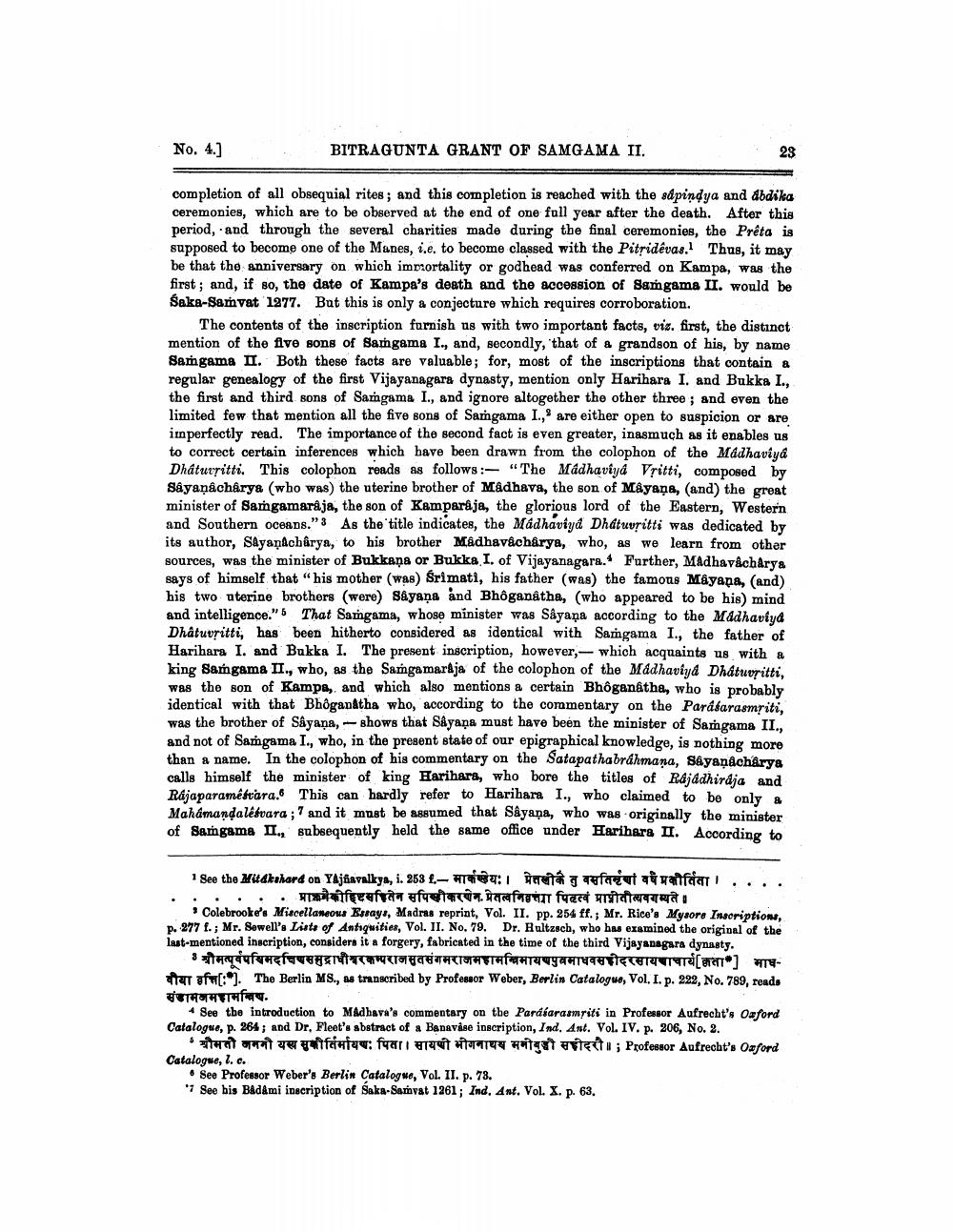________________
No. 4.]
BITRAGUNTA GRANT OF SAMGAMA II.
23
completion of all obsequial rites; and this completion is reached with the sdpindya and abdika ceremonies, which are to be observed at the end of one full year after the death. After this period, and through the several charities made during the final ceremonies, the Prêta is supposed to become one of the Manes, i.e. to become classed with the Pitsidêvas. Thus, it may be that the anniversary on which impiortality or godhead was conferred on Kampa, was the first; and, if so, the date of Kampa's death and the accession of Samgama II. would be Saka-Samvat 1277. But this is only & conjecture which requires corroboration.
The contents of the inscription furnish us with two important facts, viz. first, the distinct mention of the five sons of Samgama I., and, secondly, that of a grandson of his, by name Samgama II. Both these facts are valuable; for, most of the inscriptions that contain a regular genealogy of the first Vijayanagara dynasty, mention only Harihara I. and Bukka I., the first and third sons of Samgama I., and ignore altogether the other three ; and even the limited few that mention all the five sons of Samgama I.,' are either open to suspicion or are imperfectly read. The importance of the second fact is even greater, inasmuch as it enables us to correct certain inferences which have been drawn from the colophon of the Madhaviya Dháturritti. This colophon reads as follows:- "The Madhaviya Vitti, composed by Sâyaņâcharya (who was) the uterine brother of Madhava, the son of Mâyane, (and) the great minister of Sangamaraja, the son of Kamparâja, the glorious lord of the Eastern, Western and Southern Oceans." 3 As the title indicates, the Madhaviyd Dhatuvritti was dedicated by its author, Sayanacharya, to his brother Madhavacharya, who, as we learn from other sources, was the minister of Bukkaņa or Bukka I. of Vijayanagara. Further, Madhavacharya says of himself that "his mother (was) Srimati, his father (was) the famous Mâyana, (and) his two uterine brothers (were) Såyana and Bhóganátha, (who appeared to be his) mind and intelligence." That Sarigama, whose minister was Sayana according to the Madhaviya Dhatuvritti, has been hitherto considered as identical with Samgama I., the father of Harihara I. and Bukka I. The present inscription, however, which acquaints us with a king Samgama II., who, as the Samgamaraja of the colophon of the Madhaviya Dhatuoritti, was the son of Kamps, and which also mentions a certain Bhôganktha, who is probably identical with that Bhöganatha who, according to the commentary on the Parásarasmriti, was the brother of Sâyana, - shows that Sayaņa must have been the minister of Samgama II., and not of Samgama I., who, in the present state of our epigraphical knowledge, is nothing more than a name. In the colophon of his commentary on the Satapathabráhmana, Sêyandcharya calls himself the minister of king Harihara, who bore the titles of Rajadhirdja and Rajaparaméftara. This can hardly refer to Harihara I., who claimed to be only & Mahamandalesvara; 7 and it must be assumed that Sayana, who was originally the minister of Samgama II., subsequently held the same office under Harihara II. According to
See the Mudishard on Yajfavalkya, i. 268 £.- Are: Berita 7 ufriet vanda! .... . . . . . . *bfquefa efetaren funt fuer
Colebrooke's Miscellaneous Essays, Madras reprint, Vol. II. pp. 254 ff.; Mr. Rice's Mysore Inscriptions, p. 277 f.; Mr. Sowell's List of Antiquities, Vol. II. No. 79. Dr. Rultzsch, who has examined the original of the last-mentioned inscription, considers it a forgery, fabricated in the time of the third Vijayanagara dynasty.
श्रीमत्पूर्वपविमदषिचसमुद्राधीपरकम्पराजसतसंगमराजमहामबिमायणपुवमाधवसहीदरसायचाचार्य[कता"] माधer afwr:). The Berlin MS., as transcribed by Professor Weber, Berlin Catalogue, Vol. I. p. 222, No. 789, roads संगमनमहामविच.
4 See the introduction to Madhava's commentary on the Pardiarasmrit in Professor Aufrecht's Oxford Catalogue, p. 264 ; and Dr, Fleet's abstract of a Banavåse inscription, Ind. Ant. Vol. IV. p. 206, No. 2.
. strite fufus: fari aut 1949 Hatut urteta ; Professor Aufrecht's Oxford Catalogwe, I. c.
See Professor Weber's Berlin Catalogue, Vol. II. p. 78. 7 See bis Bad&mi inscription of saka-Samyat 1261, Ind. Ant. Vol. X. p. 63.




